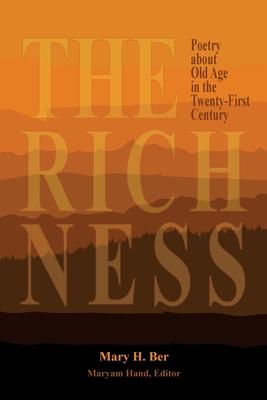The Richness: Poetry about Old Age in the Twenty-First Century is an exploration of both the positive and negative experience of old age, focusing on the often unappreciated perks. The 83-year-old author has written her experiences in easy-to-access poetry. The book is divided into six sections: "Coming Into Old Age," "Moving into the Residential Retirement Home," "Walking through Old Age," "Deepening Spirituality," "Completing Old Age," and "A Note to Caregivers." The first five sections of the book may be read as a simple collection of poems or a kind of poetic autobiography of the author's journey through this stage of her life. The author wrote the poems as she lived them. Section One, "Coming into Old Age," records initial experiences: diminishment of physical abilities, the appearance of major illness, and new spiritual reflections. "Moving into the Residential Retirement Home" continues to focus on new experiences-pleasant ones like a dining room where the servers always remember ones' name and challenging ones like the death of a spouse. The third section, "Walking through Old Age," contains poems about greater challenges along with surprising joys. Then, "Deepening Spirituality" contains a record of the kind of sacred moments that come to so many seniors during these years. "Completing Old Age " was originally meant to be the final section of the book-the record of an elder who has taken a long look back into a satisfied life, who sees it as the final piece of her whole existence. However, as the book was being put together, Aisha Sherie McGuffey, a chaplain who works with the elderly and their caregivers, saw a few of the poems. She had been looking for material that could be used in teaching caregivers how their elders felt about meeting the experiences of old age. She was so pleased at the effectiveness of these poems as teaching material that she wrote the final section, "Message to Healthcare Workers," even including a sample lesson plan. Thus, the book may be simply enjoyed by anyone as entertainment, read as validating experiences by those who are elders, or used as a textbook in a teaching situation.

The Richness: Poetry about Old Age in the Twenty-First Century
The Richness: Poetry about Old Age in the Twenty-First Century is an exploration of both the positive and negative experience of old age, focusing on the often unappreciated perks. The 83-year-old author has written her experiences in easy-to-access poetry. The book is divided into six sections: "Coming Into Old Age," "Moving into the Residential Retirement Home," "Walking through Old Age," "Deepening Spirituality," "Completing Old Age," and "A Note to Caregivers." The first five sections of the book may be read as a simple collection of poems or a kind of poetic autobiography of the author's journey through this stage of her life. The author wrote the poems as she lived them. Section One, "Coming into Old Age," records initial experiences: diminishment of physical abilities, the appearance of major illness, and new spiritual reflections. "Moving into the Residential Retirement Home" continues to focus on new experiences-pleasant ones like a dining room where the servers always remember ones' name and challenging ones like the death of a spouse. The third section, "Walking through Old Age," contains poems about greater challenges along with surprising joys. Then, "Deepening Spirituality" contains a record of the kind of sacred moments that come to so many seniors during these years. "Completing Old Age " was originally meant to be the final section of the book-the record of an elder who has taken a long look back into a satisfied life, who sees it as the final piece of her whole existence. However, as the book was being put together, Aisha Sherie McGuffey, a chaplain who works with the elderly and their caregivers, saw a few of the poems. She had been looking for material that could be used in teaching caregivers how their elders felt about meeting the experiences of old age. She was so pleased at the effectiveness of these poems as teaching material that she wrote the final section, "Message to Healthcare Workers," even including a sample lesson plan. Thus, the book may be simply enjoyed by anyone as entertainment, read as validating experiences by those who are elders, or used as a textbook in a teaching situation.